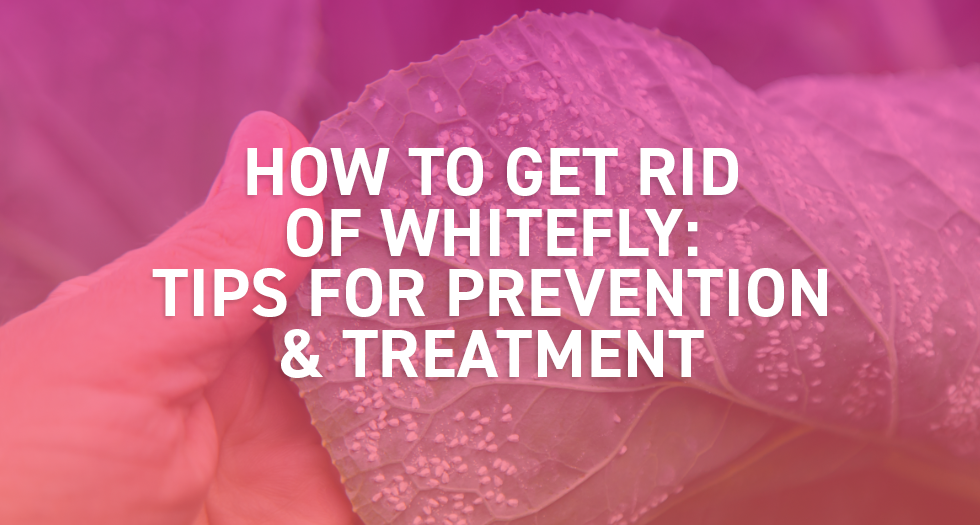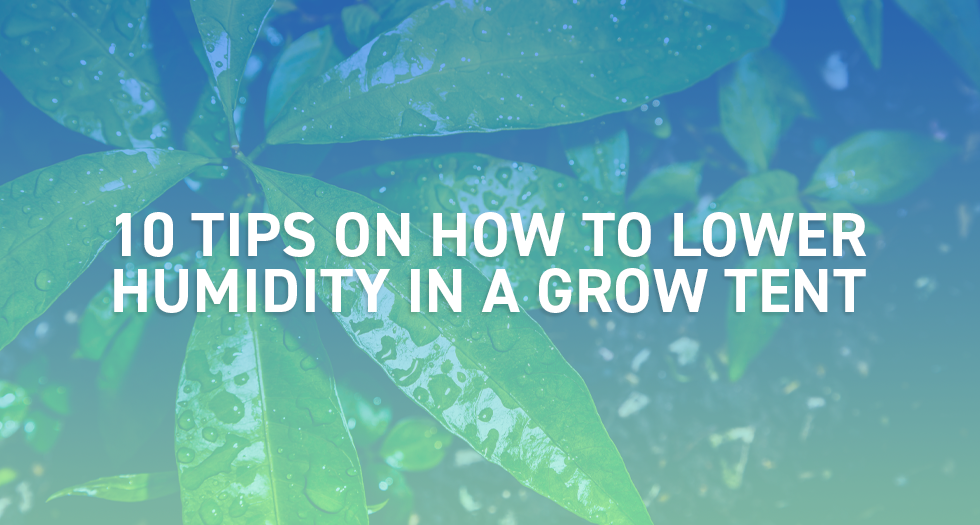Whiteflies are a common problem for growers and have the ability to cause significant damage to plants. Colonies can quickly multiply in various growing environments such as greenhouses, hydroponic gardens, allotments, and commercial growing facilities. If left untreated, infestation can lead to poor plant health, reduced yield and crop devastation. We explore how to get rid of Whitefly and ways to prevent this pest from entering your grow space.
Types of Whitefly
Whiteflies belong to the Aleyrodidae family of insects. They are miniscule insects with wings and yellowish bodies covered in a white powdery coating.
Their life cycle consists of four main stages: egg, nymph, pupa, and adult Whiteflies. Females lay eggs on the underside of leaves to protect them from predators and sunlight. The eggs hatch into nymphs which feed on plant sap then develop into pupae, finally emerging as winged adults.
There are many different species of whitefly, with around 1400 recorded globally. In the UK, common whiteflies include Glasshouse, and Cabbage Whiteflies.
Cabbage Whiteflies (Aleyrodes proletella)

Cabbage Whitefly, also known as Brassica Whitefly, is a common pest that favours brassicas such as kale and cabbage. Adults measure around 1-2mm long, have yellowish bodies with a powdery coating and hold their wings above their bodies in a tent-like manner.
Glasshouse Whitefly (Trialeurodes vaporariorum)

Also known as Greenhouse Whitefly, this pest is commonly found in indoor gardens and greenhouses across the world. Like the Cabbage Whitefly, adults measure at around 1-2mm long and have white powdery wings and yellowish bodies. This species holds its wings flat, in a tent-like manner making it difficult to see the body.
Bemisia tabaci (Also known as Tobacco, Sweet Potato or Silverleaf Whitefly)

B. tabaci is a quarantined whitefly in the UK. It is a major global pest that is resistant to numerous pesticides. Although not established in the UK, it has the potential to thrive in protected environments.
Two biotypes of particular concern (B biotype and Q biotype) have been intercepted on imported plants. Suspected outbreaks of B. tabaci must be reported to the relevant authorities.
Although difficult to distinguish from Glasshouse Whitefly, B. tabaci is a tiny insect measuring about 1mm in length. Males tend to be slightly smaller than females. They have a powdery white coating on their bodies and their eggs are oval and a light brown.
Their eggs measure around 0.2mm and are laid randomly, in partial circles or in small groups on the underside of leaves. In comparison, Glasshouse Whiteflies always lay their eggs in partial circles, are a greyish colour and noticeably darker. Unlike Glasshouse and Cabbage Whiteflies, B. tabaci hold their wings above the body and slightly apart. More advice on distinguishing B. tabaci from other species can be found here.
What Damage Can Whitefly Cause?
Whitefly infestations are detrimental to agricultural and ornamental plants. These tiny little sap sucking flies cause damage, stress, stunted growth, and wilting, affecting plant health and yield. Not only this, but the damage left behind creates openings for bacteria and disease to enter.
As well as causing damage to plants, Whiteflies are also vectors for various viruses and diseases. These include Tomato Yellow Leaf Curl Virus (TYLCV), Cucumber Mosaic Virus (CMV), Bean Yellow Mosaic Virus (BYMV), Tobacco Mosaic Virus (TMV), Begomoviruses, and more.
Whitefly excrete excess sugars and water onto host plants which is known as honeydew. Honeydew is a sticky clear honey-like substance that accumulates on the leaves and stems of infested plants.
Honeydew provides a source of nutrients for fungi to grow, such as black sooty mould. Sooty mould presents as a black powdery coating on leaves and stems. It blocks sunlight from reaching cells resulting in reduced photosynthesis and weakening of the plant.
As well as this, honeydew can attract ants. Ants have a tendency to defend honeydew-producing insects to protect this food source, helping infestations thrive. Ants can also spread disease and pathogens as they move between plants and nests. They may also build nests in the grow environment which can disturb root systems and contribute further to poor plant health.
How to Prevent Whiteflies & Manage Infestations
Careful management of the grow space can mitigate the risk of infestation. Follow these steps to prevent Whiteflies from ruining your plants.
New plants and cuttings should always be kept away from the grow space until you are certain they are pest free. Carefully inspect plants for evidence of Whiteflies including eggs, nymphs and adult plants on leaves and stems. The quarantine period should be long enough to allow time to observe any changes in plant health or evidence of pests. This is normally around 1-2 weeks.
Regularly inspect plants for symptoms of pest infestation. These include yellowing, wilting leaves, visual damage, stunted growth, and evidence of honeydew.
Remove and carefully dispose of infested foliage. This will drastically reduce the Whitefly population making management and treatment easier.
Gently vacuuming the grow space will help to control Whitefly populations. Use a handheld vacuum cleaner to carefully remove the pests from leaves and stems. Ensure to focus on the underside of leaves where they tend to congregate.
Place sticky traps in the grow space to capture unwanted pests. Glue strips like Guard’n’Aid Insect Catchers are designed to catch flying insects. These yellow sticky traps are also great for identifying pests when caught.
Ladybirds, parasitic wasps and lacewings are all natural predators of whiteflies. Careful introduction of these beneficial insects can help control whitefly and reduce the risk of severe infestation.
Bioline produces a range of biological pest control products including Encarline Whitefly Predators which contains 10,000 miniscule parasitic wasps in a vial. Simply release them in the evening when it’s cooler and watch as they seek and destroy Whitefly nymphs.
Spray the leaves and stems of affected plants with appropriate pest control soap or neem oil. The solution smothers the insects, disrupting cells and suffocating them, leading to their demise. Always mix the solution as directed by the manufacturer for the best results.
It is best to apply treatment in the evening or when it is cooler. This will prevent the solution from evaporating too quickly. Ensure to focus on the underside of the leaves where Whiteflies like to congregate. Reapply as directed (usually between 5-14 days) to break the life cycle and ensure newly hatched nymphs are targeted.
Regularly inspect your plants and adjust the frequency of treatment as required depending on the severity of the infestation. Always follow safety instructions and wear protective gloves during treatment.
Like many other pests, Whiteflies favour warm, humid conditions. If you are growing plants indoors or inside a greenhouse you should ensure adequate ventilation and airflow. Use a dehumidifier to control humidity in the grow space as required.
Reflective mulch is a type of ground cover made from reflective materials. Light reflects upwards, confusing and disorienting whiteflies. This helps to deter them from settling on host plants.
If you are growing plants indoors, ensure the area is well sealed to prevent pests from entering. Inspect the grow tent, room or growing facility for entry points, checking for gaps with a focus on doors, windows and vents.
Fill gaps in walls, window and door frames with suitable filler such as caulk. Use fine mesh screens over vents and windows. Install appropriate door seals and screens to prevent entry points for pests.
Conclusion
Whiteflies are a common pest that affects both outdoor and indoor plants. Whether you are preventing Whiteflies or tackling an infestation, understanding their lifecycle and recognising signs of infestation is essential for effective prevention and treatment. Regular monitoring and early intervention are key to successful management.




